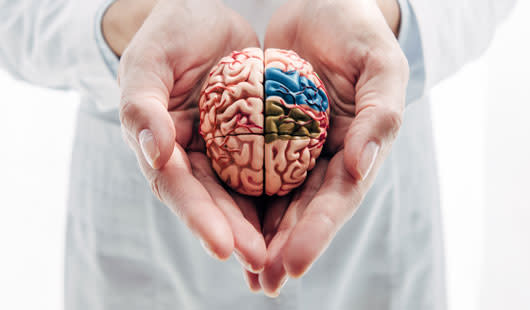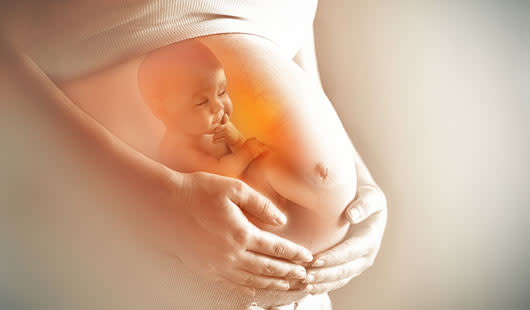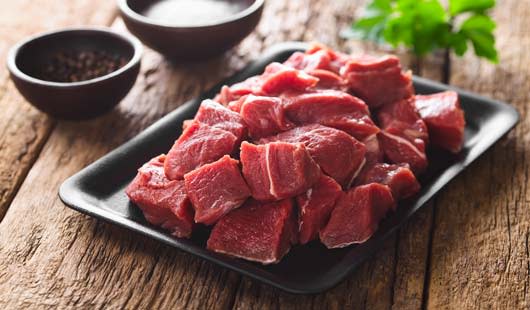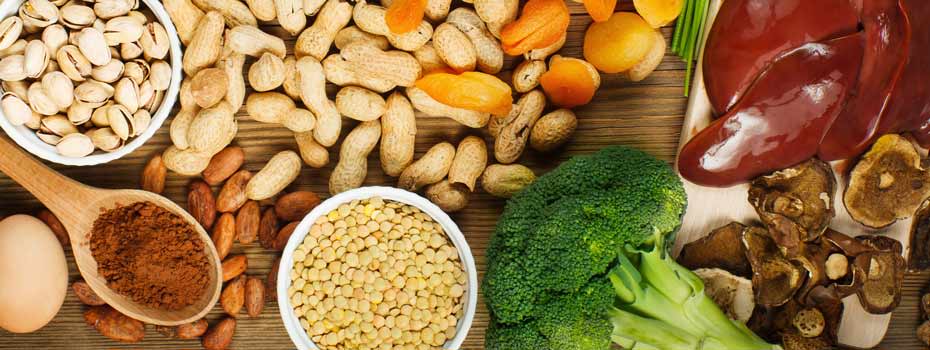Iron: The definitive guide
Iron is one of the most abundant elements on Earth, and is essential for living organisms: it has a central role in haemoglobin formation and oxygen transport. Iron is truly a Goldilocks nutrient: too little can lead to anemia, too much can lead to liver and heart problems.
Here we provide an overview of this essential nutrient, and what we can do to ensure we consume just the right amount.
- What is iron?
- Iron in the body
- What does iron do?
- How can I get enough iron?
- Diseases of iron metabolism
- Supplements
- Summary
- References
What is iron?
Iron represents about 5% of the earth’s crust, making it one of the most abundant elements on Earth1. Despite its abundance, iron is strangely a limiting factor for life: in contact with oxygen, iron forms oxide (most commonly seen as rust), which is highly insoluble and not available for organisms.
The Egyptians, Greeks and Romans were aware that iron was important for health, and was commonly used in the 17th century to treat chlorosis (green disease), a condition commonly resulting from iron deficiency. However it wasn’t until the early 20th century that we really understood iron’s central role, when it was confirmed that inorganic iron was needed for haemoglobin formation, a molecule in red blood cells that carries oxygen from our lungs to the rest of the body2.
Iron is a transition metal that can easily donate and accept electrons: this ability to move between ferric (Fe3+) and ferrous (Fe2+) state allows iron-containing proteins to participate in oxidation-reduction reactions, many of which are essential for fundamental biological processes in our bodies, such as oxygen transport and respiration3. At the same time, this reactivity can lead to toxicity: in presence of oxygen, iron can produce free radicals which can easily damage cellular structures. Therefore, organisms have developed multiple systems to control iron4.
Iron in the body
It is important to remember that our bodies are not very good at getting rid of excess iron and we don’t have a physiological process of iron excretion. The body achieves iron balance through a balanced diet and by regulation of transport and recycling5.
In the body, iron is found in two main forms6.
- Haem (heme) iron (Fe2+): in this form, iron is bound to hemoproteins. These proteins contain a haem group and have the ability to bind oxygen in the presence of iron atoms. This represents about 70% of the iron in the body. Haemoglobin, found in red blood cells, comprises about 60% of the iron. Other hemoproteins include myoglobin, found in muscle cells (about 10% of the iron) and cytochrome proteins3.
- Non-haem (non-heme) iron (Fe3+): in this form, iron can be found in iron sulfur cluster proteins such as respiratory complexes I-III and coenzyme Q10. It is also bound to transporter proteins such as transferrin and ferritin.
Apart from erythrocytes (red blood cells) and muscle, iron is mainly found in the bone marrow, spleen and liver. This is not surprising considering that the bone marrow is the production site for erythrocytes, and liver and spleen are regulatory and recycling sites on iron, respectively.
When not being used, iron is stored in a storage protein called ferritin. A protein called transferrin, found in the plasma, is responsible for moving iron to the different organs when needed. A hormone called hepcidin, mainly produced in the liver, is a central regulator of iron in the body, controlling absorption and iron transport7.
When doctors suspect there might be a problem with iron in the body, they are likely to look at the levels of some of these proteins, as it can help them to understand what might be the issue.
What does iron do?
Although iron is mostly known for its role in oxygen transport around the body and red blood cell (erythrocyte) formation, there are many other important processes where iron is essential.
Red blood cells, oxygen transport and energy
One of the most common symptoms of iron deficiency is fatigue, weakness and shortness of breath. This happens because our body cannot make enough haemoglobin and there is not enough oxygen being transported to the tissues2.
How do we make red blood cells?
Most of the iron in the body is used by the bone marrow tissue to make new haemoglobin and red blood cells.). In the lungs, haemoglobin binds to oxygen and transports it to the rest of the tissues in the body.
Haemoglobin is in fact a combination of four chains, each containing an iron atom within a haem group. This incredible structure allows iron to effectively bind to gases such as oxygen and to transport them around the body to where it is needed8.
How much haemoglobin we need depends on multiple factors: for example, exposure to high altitude (lower oxygen conditions) and severe blood loss will increase haemoglobin production.
What is Myoglobin?
In contrast to haemoglobin, myoglobin contains just one haem group with one iron atom. The main function of myoglobin is to supply oxygen to the muscles, in particular to heart and skeletal muscle. Myoglobin is very efficient at taking oxygen from blood, and it serves as an oxygen reservoir in muscle9.
Energy production inside the cell
Haemoglobin and myoglobin are responsible for delivering oxygen to the cells. Inside the cells, the mitochondria (a cellular structure commonly known as the “powerhouse” of the cell) uses this oxygen to produce ATP. ATP is an essential molecule that our cells use as fuel for pretty much everything. ATP is made via a series of chemical reactions that depend on iron-containing proteins (namely, the mitochondrial complexes I, II and III)10.
Brain health and cognition

The brain is a highly active tissue which consumes large amounts of oxygen. Therefore, given iron’s role in oxygen transport and energy, it will not come as a surprise that iron is very important for brain health.
Iron is also vital for axon myelination. Myelin is a substance that covers that axon of neurons and facilitates neural transmission: in other words, myelin ensures that neurons in your brain can work properly11.
Iron is also critical for neuronal differentiation and proliferation12, and for production of several neurotransmitters such as dopamine and norepinephrine3. Iron deficiency, especially during infancy and adolescence when our brains are still developing, has been linked to decreased conscious mental activity and mental developmental problems13.
At later stages in life, the concentration of iron in the brain tends to increase, probably due to several factors that can affect the iron regulatory system. The accumulation of iron in neurons might induce cell damage through the excessive production of free radicals12.
Iron accumulation in the glia (supporting cells in the brain) can lead to inflammation and release of pro-inflammatory cytokines, which in turn can result in a cycle of continuous inflammation and neurodegeneration14.
Iron accumulation has been associated with increased risk of neurodegenerative diseases such as Alzheimer’s or Parkinson’s14.
Pregnancy and fetus development

During pregnancy, requirements for iron increase: iron is required for cell division and proliferation, and therefore more iron is needed to support fetal growth and maternal adaptation to pregnancy, such as placental development. The iron demand increases as pregnancy progresses, and it is estimated that an additional 1 gram of iron is needed during pregnancy to maintain the mother’s iron balance and to support the development of the fetus and placenta15.
In adults, most of the iron goes to produce red blood cells. In infants and children, there is great demand for iron for muscle growth and myoglobin production. Neurological development is high during infancy, which also increases the demand for iron.
Prevalence of iron deficiency is high during pregnancy, and it is estimated that over 20-30% of pregnant women worldwide are anemic due to iron deficiency13. While iron supplementation is a common policy worldwide, in the UK, iron supplementation during pregnancy is not recommended unless there is evidence of mothers being anemic16.
At birth, most full-term babies have enough iron and haemoglobin concentrations for the first 6 months, after which iron stocks will need to be replenished13. Breast milk has low amounts of iron, but it is mainly found in iron-binding proteins such as lactoferrin. This makes iron in breastmilk highly bioavailable17. It is recommended that complementary feeding is introduced about 6 months of age to meet the growing iron requirements18.
As iron is mainly obtained from the diet, it is very important that children have a diverse diet that includes a variety of iron-rich foods to ensure an appropriate intake of iron. In many Western countries, like the UK, fortified cereals have become a major source of iron for growing children19.
Iron and the immune system
It’s not common knowledge that iron plays an important role in supporting the immune system and helping us fight infections. Iron is important for cell division and growth, and it’s necessary for differentiation and proliferation of multiple immune cells, such as the T lymphocytes.
As mentioned above, iron can be toxic in the presence of oxygen as it generates free radicals: this is commonly known as the Fenton reaction. Fenton reactions can be harmful when they happen unintentionally; but some of our immune cells, known as neutrophils, use this reaction to generate free radicals that are toxic and lethal for pathogens20.
Iron is involved in the production and regulation of cytokines, the signaling molecules of the immune system, necessary to create the inflammatory response that helps to fight infections20.
How can I get enough iron?

Because biologically available iron is very limited, the human body is very efficient at conserving and recycling iron3. In other words, if you don’t suffer from diseases but have low iron levels, it’s because you don’t get enough from the diet.
Due to the efficient iron recycling system, it is estimated that dietary iron provides about 5% of the iron daily requirement in adults. However, in children, 30% of the daily iron requirement has to come from the diet13.
What foods contain iron?
Iron is present in the diet in both haem and non-haem iron21.
- Haem (heme) iron: haem iron (bound to haemoproteins) is found only in animal-derived foods: mainly meat, fish and eggs. Liver, particularly from beef, is considered one of the richest sources of iron. Red meats have higher iron than white meats. Haem iron represents about 40% of the total iron content in animal foods.
- Non-haem (non-heme) iron: non-haem iron is found in animal and plant foods. Green leafy vegetables, beans, seeds and whole grains are particularly rich in non-haem iron.
Non-haem iron represents most of the iron we consume, but it has lower absorbability or bioavailability: it is estimated that about 15-40% of haem iron is absorbed, while we only take in less than 15% of non-haem iron5. Data suggests that iron bioavailability on an omnivore diet is 14-18%, whereas it is only 5-12% on a vegetarian diet21.
Absorption of haem-iron occurs after proteolytic digestion of myoglobin and haemoglobin, which releases the haem group. The haem is maintained in a soluble form so that it is easier to be absorbed by the gut cells22.
The absorption of non-haem iron can be affected by multiple factors present in the diet, both positively and negatively. The effect of these factors is less relevant in the context of an omnivore diet, but are more significant for vegetarian diets, where non-haem is the main iron source.
Enhancers (promoters) of iron absorption found in the diet are:
- Vitamin C (ascorbic acid): vitamin C has been shown to improve absorption of non-haem iron, in part by acting as a weak chelator (sequestering iron) to help to solubilise it in the intestine. Vitamin C has also been shown to improve iron mobilisation23.
- Carotenoids: studies have shown that carotenoids (such as beta-carotene, lycopene and lutein) can increase the uptake of non-haem iron24.
Inhibitors (detractors) of iron absorption found in the diet are25:
- Tannins: tannins are present in tea and coffee (as tannic acid) as well as in red wine. They are thought to bind non-haem iron in the intestine, therefore sequestering and preventing absorption21.
- Phytates: phytate/phytic acid is a compound found in abundance in whole grain cereals and legumes. Phytates have been shown to inhibit iron absorption, possibly by preventing absorption of ferritin deposits, although the exact mechanism is not clear26.
Iron and vegetarian vegan diets
Vegetarian diets are likely to have higher amounts of vitamin C and carotenoids, but they are also more likely to increase consumption of polyphenols and phytic acid, which are found in plant foods27. For people that follow a vegetarian diet, particularly women and children, the intake of iron-fortified foods is highly recommended.
Some gastrointestinal conditions like peptic ulcers, or H.pylori infections are also known to decrease iron absorption28.
The current recommendation for iron is 11mg/day for men. Pre-menopausal women should aim at 16mg/day due to loss during menstruation. Post-menopausal women should aim at 11mg/day29.
Diseases of iron metabolism
Iron metabolism is tightly regulated. When the balance tips to one side or the other, it can lead to serious disorders.
Not enough iron - iron deficiency
It is estimated that over 1.5 billion people worldwide suffer from anaemia, and iron deficiency accounts for 30-50% of the cases30. Although anaemia is especially prevalent in developing countries, it’s still an important problem in the developed world, especially in people with low incomes. Iron deficiency is more common in women than men, due to periodical loss of blood during menstruation. Iron deficiency is relatively common among the elderly population31.
People that do not eat animal products, particularly vegans, are also more likely to be iron deficient than meat eaters, due to the lower bioavailability or absorption of non-haem iron5.
In developing countries, iron deficiency coexists with infectious diseases such as malaria or hookworm, which have been shown to further affect iron status, particularly in children1.
Iron deficiency anaemia presents multiple symptoms, including fatigue and exercise-associated dyspnea (shortness of breath), paleness, headache and altered thermoregulation (internal temperature control). These symptoms, along with others, are caused by impairment of oxygen transport. Iron deficiency can also cause cognitive dysfunction, which can lead to neurological damage during brain development in children, as well as worsening cognitive function and dementia in the elderly1,28.
Oral iron supplementation is the common treatment for iron deficiency. In people with malabsorption, such as the elderly, intravenous iron injection may be more effective.
Too much iron - iron overload
Too much iron in the body is not good for you and can affect and damage the liver, heart and endocrine glands3.
Major causes of iron overload are generally hereditary. Excessive transfusions can also cause iron overload especially in people with chronic kidney disorders3.
Haemochromatosis is an hereditary disease, linked to faulty hepcidin. If this protein is not working properly, the body is unable to detect increasing iron levels and therefore cannot control the iron intake from the diet. In time, this leads to iron accumulation in the organs potentially causing liver and heart damage32.
Beta-thalassemias are hereditary disorders characterised by abnormalities in haemoglobin. This results in ineffective erythropoiesis (new red blood cell formation), resulting in hepcidin suppression and excessive absorption of iron. Beta-thalassemia is prevalent in Mediterranean countries, but it is estimated that about 1.5% of the global population are carriers33.
Interestingly, iron overload can also lead to chronic fatigue, a symptom generally associated with iron deficiency. In advanced stages of iron overload, it is common to suffer liver cirrhosis and/or diabetes due to organ damage32.
During ageing, iron accumulates selectively in specific areas of the brain. However, greater accumulation occurs in many neurological diseases, and is associated with oxidative stress and cellular damage and with Parkinson’s and Alzheimer’s disease14.
Supplements
Oral iron supplementation is the quickest and simplest way to increase the dietary intake of iron.
There are multiple types of iron supplements in the market. Iron is better absorbed in an empty stomach, but this can often cause indigestion so many people prefer to take iron with food.
Iron supplementation, particularly at higher doses, is well known for its side effects: 10-40% of people can suffer from constipation, nausea or vomiting28.
Ferrous sulphate is the most common iron supplement, also frequently used in iron fortification as it’s very cost-effective. However, it’s well known for its gastrointestinal-specific side effects and it disagrees with many people34. It’s also known to give a metallic after-taste to food.
Similarly to other minerals, supplements that supply iron in inorganic form tend to have more iron in them, but they’re not soluble and not well absorbed by the body35.
Recently, new natural sources of iron have been explored to try to reduce the side effects of iron salts36.
Fungi are known to take iron from the environment where they grow and store it for use at a later stage. One of these fungi, Aspergillus oryzae, commonly known as koji culture, is widely used in Asian cuisine to produce miso and soya sauce. Koji supplements that contain natural iron have recently been developed. The iron from koji extract has a similar absorption rate to ferrous sulphate but with much lower side effects37,38.
If you’re taking antacid medication or tetracycline antibiotics, leave at least 2 hours in between the medication and supplementation. These medications can chelate (sequester) the iron, which not only makes the supplement ineffective, but can also have an effect on the medication39.
Summary
Iron is a central nutrient for our health, and its metabolism is tightly regulated: too little iron causes anaemia, too much iron can lead to organ damage. Although iron from vegetable sources is more abundant in the diet, it’s less well absorbed than from meat. People on vegetarian and vegan diets are more likely to suffer from iron deficiency than omnivores, and therefore might want to consider external supplementation.
References
1. Miller JL. Iron deficiency anemia: a common and curable disease. Cold Spring Harb Perspect Med. 2013; 3(7):a011866
2. Abbaspour N, Hurrell R, Kelishadi R. Review on iron and its importance for human health. J Res Med Sci. 2014; 19(2):164-174
3. Dev S & Babitt JL. Overview of iron metabolism in health and disease. Hemodial Int. 2017; 21 Suppl1(Suppl 1):S6-S20
4. Sanchez M, Sabio L, Galvez N, Capdevila M, Dominguez-Vera JM. Iron chemistry at the service of life. IUBMB Life. 2017; 69(6):382-388
5. Briguglio M, Hrelia S, Malaguti M, et al. The central role of iron in human nutrition: from folk to contemporary medicine. Nutrients. 2020; 12(6):1761.
6. Kontoghiorghes GJ, Kolnagou A, Kontoghiorghe CN, Mourouzidis L, Timoshnikov VA, Polyakov NE. Trying to solve the puzzle of the interaction of ascorbic and iron: redox, chelation and therapeutic implications. Medicines (Basel). 2020; 7(8):E45
7. Chifman J, Laubenbacher R, Torti SV. A systems biology approach to iron metabolism. Adv Exp Med Biol. 2014; 844:201-225
8. Schechter AN. Hemoglobin research and the origins of molecular medicine. Blood. 2008; 112(10):3927-3938
9. Vanek T, Kohli A. Biochemistry, Myoglobin. In: StatPearls. Treasure Island (FL): StatPearls Publishing; July 26, 2020
10. Stiban J, So M, Kaguni LS. Iron-sulfur clusters in mitochondrial metabolism: multifaceted roles of a simple cofactor. Biochemistry (Mosc). 2016; 81(10):1066-1080
11. Beard JL, Connor JR. Iron status and neural functioning. Annu Rev Nutr. 2003; 23:41-58
12. Tardy AL, Pouteau E, Marquez D, Yilmaz C, Scholey A. Vitamins and minerals for energy, fatigue and cognition: a narrative review of the biochemical and clinical evidence. Nutrients. 2020; 12(1):228
13. Cerami C. Iron nutriture of the fetus, neonate, infant and child. Ann Nutr Metab. 2017; 71 Suppl 3(Suppl 3):8-14
14. Ward RJ, Zucca FA, Duyn JH, Crichton RR, Zecca L. The role of iron in brain ageing and neurodegenerative disorders. Lancet Neurol. 2014; 13(10):1045-1060
15. Fisher AL, Nemeth E. Iron homeostasis during pregnancy. Am J Clin Nutr. 2017; 106(Suppl 6): 1567S-1574S.
16. Vitamins, supplements and nutrition in pregnancy. NHS UK.
17. Andreas NJ, Kampmann B, Mehring Le-Doare K. Human breast milk: a review on its composition and bioactivity. Early Hum Dev. 2015; 91(11):629-635
18. Agostoni C, Decsi T, Fewtrell M, et al. Complementary feeding: a commentary by the ESPGHAN Committee on Nutrition. J Pediatr Gastroenterol Nutr. 2008; 46(1): 99-110
19. Fairweather-Tait SJ. Iron nutrition in the UK: getting the balance right. Proc Nutr Soc. 2004; 63(4):519-528
20. Gombart AF, Pierre A, Maggini S. A review of micronutrients and the immune system - working in harmony to reduce the risk of infection. Nutrients. 2020; 12(1):236
21. Moustarah F, Mohiuddin SS. Dietary Iron. In: StatPearls. Treasure Island (FL): StatPearls Publishing; April 30, 2020
22. Uzel C, Conrad ME. Absorption of heme iron. Semin Hematol. 1998; 35(1):27-34
23. Lane DJ, Richardson DR. The active role of vitamin C in mammalian iron metabolism: much more than just enhanced iron absorption! Free Radic Biol Med. 2014; 75:69-83
24. Garcia-Casal MN, Leets I. Carotenoids, but not vitamin A, improve iron uptake and ferritin synthesis by Caco-2 cells from ferrous fumarate and NaFe-EDTA. J Food Sci. 2014; 79(4):H706-H712.
25. Zijp IM, Korver O, Tijburg LB. Effect of tea and other dietary factors on iron absorption. Rev Food Sci Nutr. 2000; 40(5):371-398.
26. Nielsen AV, Tetens I, Meyer AS. Potential of phytase-mediated iron release from cereal-based foods: a quantitative view. Nutrients. 2013; 5(8):3074-3098
27. Hunt JR. Bioavailability of iron, zinc, and other trace minerals from vegetarian diets. Am J Clin Nutr. 2003; 78(3 Suppl):633S-639S
28. Romano AD, Paglia A, Bellanti F, et al. Molecular aspects and treatment of iron deficiency in the elderly. Int J Mol Sci. 2020; 21(11):3821
29. EFSA NDA Panel (EFSA Panel on Dietetic Products, Nutrition and Allergies), 2015. Scientific opinion on dietary reference values for iron. EFSA Journal. 2015; 13(10):4254
30. McLean E, Cogswell M, Egli I, Wojdyla D, de Benoist B. Worldwide prevalence of anaemia. WHO Vitamin and Mineral Nutrition Information System, 1993-2005. Public Health Nutr. 2009; 12(4):444-454
31. Busti F, Campostrini N, Martinelli N, Girelli D. Iron deficiency in the elderly population, revisited in the hepcidin era. Front Pharmacol. 2014; 5:83
32. Kotze MJ, van Velden DP, van Rensburg SJ, Erasmus R. Pathogenic mechanisms underlying iron deficiency and iron overload: new insights for clinical application. EJIFCC. 2009; 20(2):108-123
33. Galanello R, Origa R. Beta-thalassemia. Orphanet J Rare Dis. 2010; 5:11
34. Tolkien Z, Stecher L, Mander AP, Pereira Di, Powell JJ. Ferrous sulfate supplementation causes significant gastrointestinal side-effects in adults: a systematic review and meta-analysis. PLoS One. 2015; 10(2):e0117383
35. Swain JH, Newman SM, Hunt JR. Bioavailability of elemental iron powders to rats is less than bakery-grade ferrous sulfate and predicted by iron solubility and particle surface area. J Nutr. 2003; 133(11):3546-3552
36. Sabatier M, Egli I, Hurrell R, et al. Iron bioavailability from fresh cheese fortified with iron-enriched yeast. Eur J Nutr. 2017; 56(4):1551-1560
37. Reddy MB, Armah SM. Impact of iron-enriched Aspergillus oryzae on iron bioavailability, safety and gut microbiota in rats. J Agric Food Chem. 2018; 66(24):6213-6218.
38. Reddy MB, Armah SM, Stewart JW, O’Brien KO. Iron absorption from iron-enriched Aspergillus oryzae is similar to ferrous sulfate in healthy female subjects. Curr Dev Nutr. 2018; 2(3):nyz004
39. Campbell NR, Hasinoff BB. Iron supplements: a common cause of drug interactions. Br J Clin Pharmacol. 1991; 31(3):251-255

